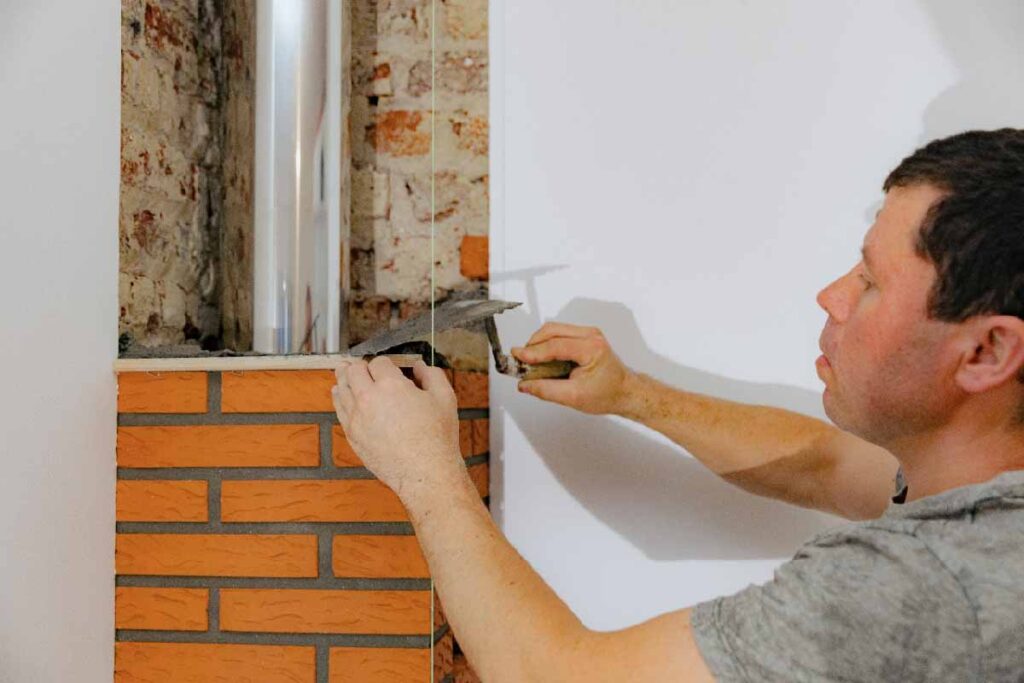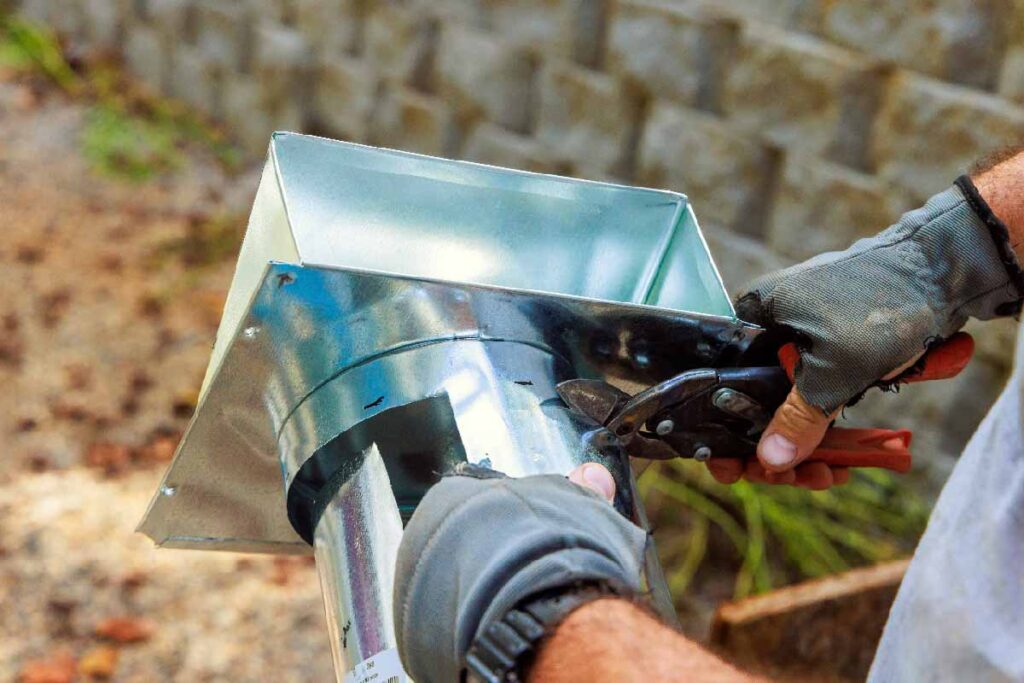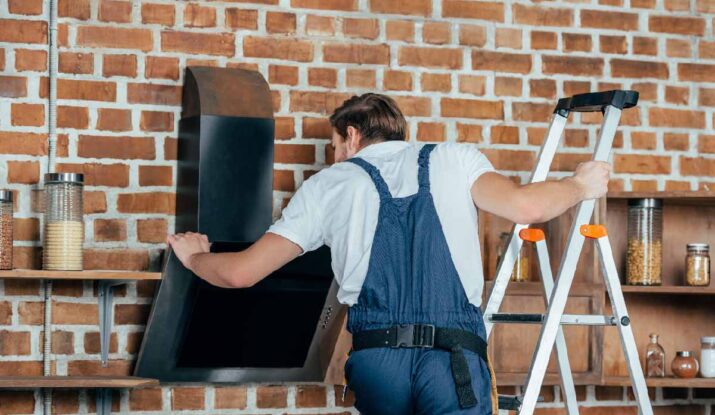Hospitals, offices, and restaurants among other business institutions require a constant and efficient supply of heat for their operations; this requires a well-maintained chimney. Chimney problems if not well addressed can cause fires, compromise air quality, or lead to expensive repairs.
Knowledge of how to repair your chimney can help avoid stress and reduce spending on unnecessary repairs. Minor issues can be addressed with small, frequent repairs. Understanding how to repair your chimney ensures it functions efficiently without hitches. Below we present the most important actions that will help you to maintain your chimney safe and protect your facility.
Types of Chimneys & Building its Structure
To effectively manage risks, it’s crucial to understand how to repair your chimney and its key structural components. All of them have their functions, which are vital for your chimney to work properly. Let’s break down some key parts.

The Flue
The flue is the unsung hero of your chimney system. This is often the initial barrier against the weather conditions that are prevailing at that particular time. The crown also seals off the flue against water, snow, and other matters that may find their way on rooftops. Nonetheless, weather reacts negatively, causing cracks or wearing out over time.
Addressing flue weaknesses promptly is a critical step in learning how to repair your chimney and prevent structural damage. It is important for the crown protecting your roof to be undamaged and able to resist water to avoid expensive repairs.
Also, it is important to check for any cracks or erosion regularly, and maybe after a storm weather conditions may be quite time-consuming and hectic.
The Crown
Picture the crown as an umbrella shielding the top of your chimney. It’s the first line of defense against the elements. The crown prevents rain, snow, and debris from entering the flue. However, weather can take a toll, leading to cracks or wear over time.
These vulnerabilities can allow water to seep into the brick-and-mortar structure, potentially causing extensive damage. Ensuring your crown is intact and waterproof is key to preventing costly repairs. Regular checks for cracks or erosion, especially after harsh weather, can save you a lot of hassle later on.
Brick and Mortar Structure
When it comes to the brick-and-mortar structure, it’s like the backbone of your chimney. But even the strongest backbone can face issues. Cracking and spalling are common issues you’ll encounter when understanding how to repair your chimney effectively.
It is normally caused by temperature changes that make the materials, for example, expand due to heat and crack due to coldness. While spalling is part of the brick face or skin chipping and flaking particularly because of water penetration.
Here are a few tips to manage these issues:
- Regular Inspections: You should closely monitor your chimney for cracks because they can be signs of a demeaned structure. Hearing complaints before this time makes their repairs easy and cheaper as compared to those that are so severe that you have to fix them during remodels.
- Proper Waterproofing: It should be recommended to apply a water repellent that will reduce or even completely prevent water from penetrating bricks.
- Timely Repairs: Tackle minor splits in home walls and floors before they turn into complex structural issues.
Understanding these components and taking preventive measures plays a huge role in maintaining a healthy chimney, ensuring your business remains warm and welcoming.
Recognizing Chimney Problems the Most
Recognizing signs of damage is the first step in mastering how to repair your chimney and avoid costly repairs. Being proactive implies looking at typical signals that suggest a potential for a loss in safety or efficiency. It will be helpful to preface our examination with the most common suspects you are likely to meet on your chimney repair expedition.
Cracks in the Masonry
Masonry cracks can seem minor, yet they can signal underlying issues. Visual inspections are your first line of defense. Check for cracks by examining the chimney exterior.
Look for small lines on the bricks which may appear in patterns like stair steps. Horizontal cracks are particularly dangerous, though, and they should not be ignored by any homeowner. Now bricks which are just the outer of your chimney can be compared to our skin, and when both get; breaks we simply don’t like to let it heal on its own.
Deteriorating Mortar Joints
Mortar joints are similar to the cement holding your chimney bricks together and if they crack it will lead to big problems. However, they wear out due to tough weathering and normal use over the society’s floors and other structures. Here’s how you can spot the signs:
- Chunks of Mortar Falling Off: Notice any loose mortar pieces on the ground? That’s an immediate red flag.
- Receding Mortar: If they seem to be sinking inwards or appear to have no bulkhead then it may be time for a little repair work.
- Discoloration: This may signal moisture penetration that has a demoralizing effect on the mortar.
Catching these early can prevent more costly repairs in the future since your chimney is as strong as it was.
Water Damage and Leaks
There are few things worse for a chimney than leaving the water damaged to rule the household. It can seep through the crevices and spaces in wall joints and badly shaped and laid mortar.
Eventually, the structure weakens from the inside due to rusting, growth of mold, to even complete collapse due to the presence of moisture. Here are classic signs of water-related issues:
- Efflorescence: This is the white staining on the chimney’s surface, suggesting moisture escape.
- Visible Water Stains: Inside your property, on the ceiling or walls near the chimney.
- Musty Odor: It indicates mold or mildew resulting from moisture build-up.
Spotting water-related damage early is key to understanding how to repair your chimney and keep it in optimal condition. Water problems caught early and resolved mean that your chimney remains effective and your operations continue uninterrupted.
List of Materials Required for Chimney Repair
Having the right tools and materials is essential when learning how to repair your chimney efficiently and safely. In addition to this, it also reduces the various risks that could be associated with the job to have it done effectively. A business owner should possess all these to ensure safety and functionality in the facility.

Chimney Repair Tools and Materials Table
| Category | Item | Purpose |
| Essential Tools | Trowel | Applying and smoothing mortar. |
| Brick Hammer & Chisel | Removing old bricks and shaping replacements. | |
| Wire Brush | Cleaning surfaces and removing soot. | |
| Mixing Bucket | Preparing mortar or cement. | |
| Caulking Gun | Applying sealant to small cracks. | |
| Extension Ladder | Safely reaching high, hard-to-access areas. | |
| Repair Materials | Mortar & Refractory Cement | Brickwork and handling high temperatures. |
| Sealants | Sealing cracks and fastening flue liners. | |
| Water Repellent | Preventing water infiltration on bricks. | |
| Flashing Repair Kits | Fixing roof flashing to prevent leaks. | |
| Chimney Crown Repair Products | Sealing cracks in the chimney crown to avoid water damage. |
Comprehensive Step-by-Step Guide: How to Repair Your Chimney
Maintaining your chimney clean and well-functioning is not just a routine- it’s a necessity for your business.
Solutions like fixing chimneys may seem cumbersome when discussed in their broad sense, but if elaborated on phases it becomes easy to handle.
Preparing for the Repairs
To summarize, preparation is your first and best protection if you are getting ready to make some repairs. Safety is key:
- For your hands and eyes to be safe from dust and debris ensure you use strong hand gloves and eye goggles.
- If you are climbing, make sure you have a good solid ladder slanting properly and firmly anchored.
- The final and most essential one is to check the weather forecast and not go on working on the roof in the rain or wind.
- Section any chemical sealants or mortars you plan to use and make sure adequate ventilation is provided.
Preparation is a vital part of understanding how to repair your chimney and ensuring safe, successful outcomes.
Repairing Cracks in the Brick
Fixing brick cracks is a key aspect of learning how to repair your chimney and maintain its structural integrity. Here’s how to fix them:
- Clean the area: Clean by using a wire brush to take off the remaining dust and any small objects in the crack.
- Apply a sealant: Select a masonry crack filler that is appropriate and use the caulk filling in a caulking gun to fill the cracks thoroughly.
- Smooth it out: To finish the work scrape the excess sealant using a trowel, then aim to achieve a flat surface touching the adjoining bricks.
Getting this done right ensures that your chimney remains structurally sound.
Repointing Mortar Joints
Mortar joints hold everything together. Here’s how to recapture their integrity:
- Remove old mortar: Another step would be to crack off loosened and old mortar with a chisel and hammer.
- Clean and wet the joints: Pat off the dust and then wet the area very slightly with water.
- Apply new mortar: Trowel a new mortar and place it into the joints.
- Finish the joints: Proper the mortar slabs and tiling with a joint tool to achieve a professional outlook.
Repointing mortar joints is an essential technique in mastering how to repair your chimney effectively.
Sealing the Crown
The chimney crown is its first defense against weather, and sealing it is vital:
- Clean the crown: Scrub the grime or plant growth off and if it is difficult, use a stiff brush.
- Apply a waterproof sealant: Spread the chimney crown sealant over the surface of it by using a brush gently.
- Check for sealing completeness: Ensure that there aren’t spaces in which water could infiltrate.
Sealing the crown is a critical step in understanding how to repair your chimney and prevent extensive future damage.
Chimney care goes Beyond aesthetics let alone benefiting the overall appearance of your business; it helps in minimizing future hazards. How to repair your chimney and maintain it effectively ensures safety and warmth for your business operations.
Preventative Maintenance for Your Chimney
Learning how to repair your chimney and practicing preventive maintenance is essential for safety and efficiency. Chimney care is not only a matter of keeping smoke out of your business site, but is also a safety and economical necessity. It pays to get them right because otherwise, bigger problems will arise, which will take time to fix. Now it is high time to turn to some effective preventative steps to ensure the proper functioning of your chimney.

Regular Inspections
When you have your chimney in place, the best thing you can do is schedule for chimney inspection after a certain period. When must you consider inspecting your chimney? The experts propose that the vehicle should undergo professional inspection at least once every year.
However, if your business depends on heating systems such as fireplaces, you should do it at least twice per year, before the peak usage period such as during the cold winter season, and after. In the course of an inspection, an accredited person will factor in areas of crack, blockage, or general areas that may require repair among others.
Despite the name indicating that a sweep and inspection is often done only once a year, it is more of a routine check-up for your chimney.
Routine Cleaning Practices
As with other cleaning schedules that maintain the cleanliness of the offices, the same applies to cham cleaning to maintain the health of the chimney. Here are some tips to help maintain your chimney’s performance:
- Use the Right Tools: Opt for a wire brush that fits your flue’s diameter. This makes sure that you will be in a position to scrub off soot and any created creosote from the chamber.
- Schedule Regular Sweeping: It is ideal to clean your chimney every year but if you find much soot this should be done more often.
- Cover the Area: To begin with, one must cover furniture and the floor to avoid soot and dust preparations from reaching and staining.
- Safety First: Use goggles, gloves, and a mask to protect yourself from soot and particles flying around during construction. For safety’s sake, it will be wise to keep around a fire extinguisher.
Besides, Routine cleaning is a proactive step in understanding how to repair your chimney and extend its lifespan, since it will not be drenched thoroughly in residue. Is it a hassle? Perhaps—but considering the costs which are incurred on chimney repairs, the actual work is rather easy.
wipe or sweep, you are not only maintaining your flue but also protecting your enterprise from fire and operational losses.
When to Call a Professional
While learning how to repair your chimney can handle minor issues, certain tasks are best left to professionals. This section will help you navigate to understand when it is safe to let the professionals do their job.
Structural Damage
Structural damage can be described as a force or action that should not be taken lightly. If for instance, you realize that your chimney is leaning or has large crevices, it is time to call for chimney repairs.
Such sort of damage may be a sign that the chimney has structural problems right from the bottom up or that it is unstable. Just like a vertical line in the car’s frame, giving the car a free tune without the mechanic’s verdict would not be wise for anyone, would it? An expert person can give the degree of fatal disaster and how one should avoid the danger completely. Signs to watch for include:
- Large, visible cracks in the masonry.
- Water damage signs, like stains or pooling at the base.
- The chimney leaning or sagging.
Attempting to repair such damage on your own can lead to safety hazards and even more extensive repairs down the line. Trust the professionals to ensure everything remains secure and compliant with safety standards.
Complex Repairs
Not all chimney repairs are straightforward. Some tasks demand specialized skills and equipment. Complex repairs, such as chimney relining, crown replacement, or fixing major leaks, should be left to those who tackle such challenges daily. Imagine trying to perform surgery without training—it’s risky and not recommended. These experts have the experience to ensure repairs meet both safety and efficiency standards.
Consider calling in a professional for:
- Replacing a flue liner.
- Extensive tuckpointing or rebuilding.
- Dealing with persistent water leaks.
If there’s anything more significant than calling a professional, then it is doing so when you are certain that your chimney is compromised and your business is in danger. One way of preventing such small problems from developing into major ones is to keep your chimney in the hands of professionals.

Frequently Asked Questions
Can you tell me when a chimney needs repair?
Look for cracks, missing bricks, crumbling mortar, water damage, or a smoky smell indoors. If you’re unsure, have a professional inspection.
What are frequent kinds of chimney repairs?
They include crack repair, replacement of bricks, mortar reparation, sealing, installation, and repair of chimney caps among others.
Is it possible to repair a chimney on one’s own?
It is possible to engage in cosmetic works such as the sealing of minor cracks or the replacement of a cap. If you suspect that you have a structural problem or do not feel safe climbing on your roof, seek help.
How much does a chimney repair cost?
Costs vary depending on the repair type and severity. Simple repairs might cost a few hu
Conclusion
A healthy chimney is invaluable to maintain the safety and comfort in your business environment, regardless if it operating a restaurant or an office. Preventive maintenance is especially important, it helps eliminate more comprehensive problems that may cause more significant troubles.
Understanding the basics of how to repair your chimney—like maintaining a clean flue, strong mortar joints, and a sealed crown—ensures safety and smooth operations. Tending to these areas proactively means you can avoid downtimes and keep your business running smoothly with chimney repair.


